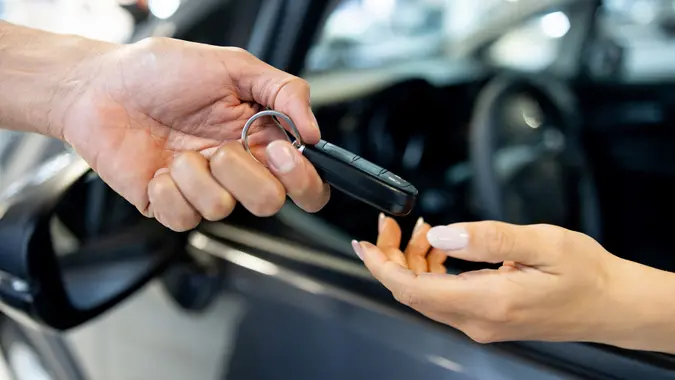4 Ways To Let Your Paycheck Work for You When Purchasing a Car

Commitment to Our Readers
GOBankingRates' editorial team is committed to bringing you unbiased reviews and information. We use data-driven methodologies to evaluate financial products and services - our reviews and ratings are not influenced by advertisers. You can read more about our editorial guidelines and our products and services review methodology.

20 Years
Helping You Live Richer

Reviewed
by Experts

Trusted by
Millions of Readers
Purchasing a car is one of the most consequential financial decisions a person can make. Buying a big-ticket item financed with a big loan can come with big consequences for years to come if you get it wrong.
The good news is that anyone who is gainfully employed can leverage their paycheck to their advantage throughout the entire purchasing process, from planning to signing on the dotted line. Here are four ways that you can make your paycheck work in your favor when it comes time to purchase a car.
Use It To Gauge Your Purchasing Power
Shopping for just the right vehicle starts with knowing the price range in which to shop — and the answer is right there on your paycheck.
Clark County Credit Union issued guidelines that echo conventional car-buying wisdom — cap the purchase price of your vehicle at 35% of your annual income.
For example, if your household earns $75,000 a year, shop for vehicles that cost $26,250 or less.
Use It To Calculate a Manageable Monthly Payment
Most people don’t have the cash to pony up 35% of their annual income for a new set of wheels, which means that buying a new or used car comes with the burden of monthly payments — but just how much burden can you afford?
Your paycheck can also provide the answer here.
LendingTree said to use the 20/4/10 rule: Put 20% of the vehicle price down, cap the loan term at four years and spend no more than 10% of your monthly gross income on transportation costs — which include your car payment, insurance premiums and ownership expenses like gas.
The household earning $75,000 annually makes $6,250 per month, which leaves them $625 per month to spend on their car, including their monthly payment and associated costs.
Use It To Automate Down Payment Savings
The household earning $75,000 and hoping to purchase a $26,250 car would need a down payment of $5,250 to adhere to the 20/4/10 rule — and their paycheck is the key to coming up with the cash.
In a tutorial on saving money to buy a car, Chase Bank said to combine the power of automation and bucketing, which most banks and credit unions now make easy to use. To make it easy and stay consistent, use your bank’s app to automatically divert a portion of your monthly income into a special savings bucket dedicated to your down payment the moment your paycheck arrives.
Use It To Make Lenders Compete
According to Navy Federal Credit Union, one of the keys to savvy car-buying is to enter negotiations armed with pre-approval from a third-party lender. This way, you can take the dealer’s financing offer if it’s the best you can do, but not get stuck with it if it’s not.
Lenders will use your paycheck — along with your credit score and other factors — to determine how much to approve you for and at what rate. If it’s better than what the dealer’s financing office has to offer, the dealer could even sweeten the pot by lowering their rate to beat your preapproval rate in an effort to secure your business.
 Written by
Written by  Edited by
Edited by 
























